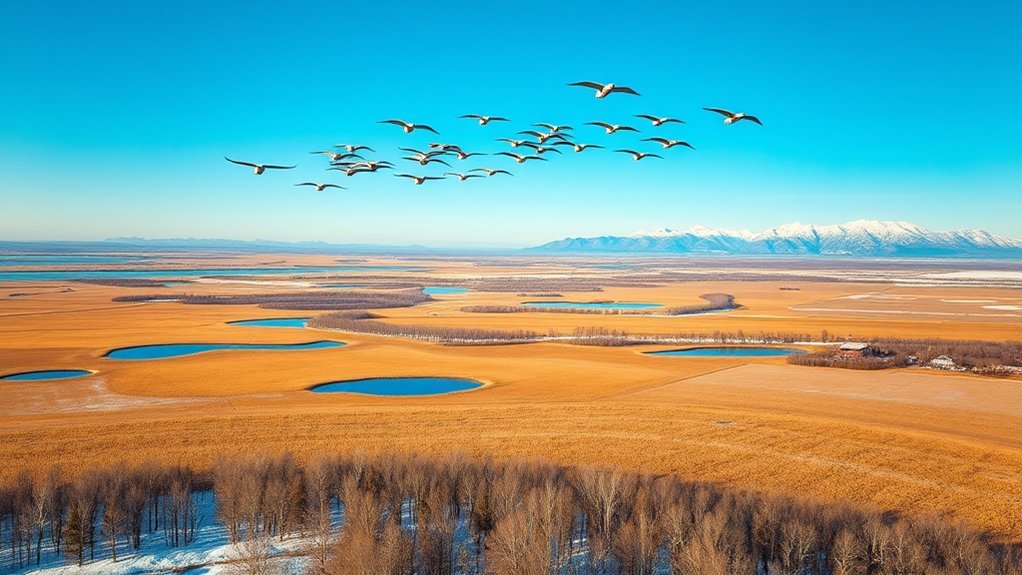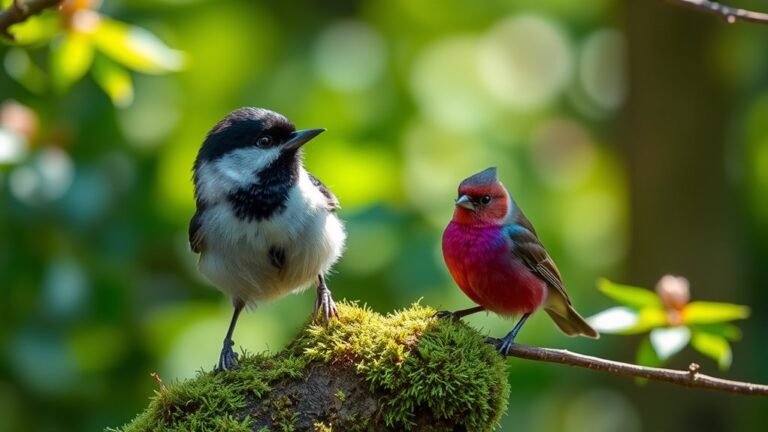Where Do Birds Go in Winter? Migration Patterns Explained
When winter comes, many birds migrate to find warmer areas. They leave their breeding grounds because of the cold and lack of food. These migrations follow specific routes based on where food is available and where they can find good habitats.
Birds use various methods to find their way during these long journeys. They face challenges like bad weather and predators. Birds have special adaptations, such as strong wings and keen eyesight, that help them survive their trips. Understanding these migration patterns can show us how resilient and resourceful birds are.
Key Takeaways
Many birds migrate in winter to warmer areas. They do this to escape cold weather and find food. Migration leads birds to breeding grounds with plenty of food. Different bird species take unique routes during their migrations. They often stop at important locations to rest and replenish their resources. Some birds migrate at different times, with adult birds leaving earlier than younger ones. Weather and seasonal changes greatly affect when and where birds migrate.
Understanding Bird Migration
Bird migration is driven by key factors like breeding grounds and food availability. Breeding grounds are essential for reproduction, helping birds ensure their species' survival. These areas often have plenty of resources, creating good conditions for nesting and raising young.
As seasons change, food supplies can vary, leading many birds to migrate to places where food is more abundant. The need for suitable habitats and reliable food sources shapes these migration patterns. This connection shows how environmental conditions affect bird behavior.
Migrating birds have special traits that help them travel long distances to find ideal breeding areas and necessary food. These adaptations support their journeys and enhance their chances of survival.
Understanding bird migration reveals the beauty of nature and the lengths these creatures go to thrive.
Reasons for Migration
Birds migrate for several important reasons that support their survival and reproduction. They move to find better breeding areas and food supplies. As seasons change, many birds go to warmer climates where food is abundant. This helps them survive and provides good conditions for raising young birds.
- Birds nest in safe environments with plenty of resources.
- They avoid harsh winter weather.
- They look for areas with abundant food.
- Migrating increases their chances to reproduce.
- Successful migration helps young birds develop well.
This behavior is essential for maintaining bird populations and ensuring their future.
Types of Migration
Many species show different types of migration that reflect their survival strategies. There are two main patterns: seasonal migration and differential migration.
Seasonal migration occurs when birds travel long distances to find better living conditions. They follow specific routes and often stop at key locations to rest and eat.
Differential migration is different. It happens within a species based on age or sex. For example, adult birds may leave or arrive earlier than younger birds. This timing helps them survive and access resources more efficiently.
Understanding these migration types is important. Each route and stopover location is crucial for the health and survival of birds during their journeys.
Navigation Techniques Used by Birds
Birds employ sophisticated navigation techniques to guarantee successful migration.
You'll find that many species utilize celestial navigation, relying on the sun, stars, and even the Earth's magnetic field to chart their courses.
Understanding these methods sheds light on the astonishing capabilities birds have developed for long-distance travel.
Celestial Navigation Methods
Birds travel great distances during migration. They use simple techniques to find their way, using cues from the sun and stars. During the day, birds follow the sun. At night, they look to the stars. This ability helps them stay on course, even in tough weather.
- Watching a starry night sky is thrilling.
- The mystery of their journeys keeps us curious.
- Nature's design helps birds survive.
- Synchronized flocks flying together is beautiful.
- Their hard work inspires us.
By adjusting their paths with celestial signals, birds show how well they adapt to their environment.
Their remarkable journeys remind us of the magic of nature.
Magnetic Field Awareness
Various elements affect how birds find their way, but awareness of magnetic fields serves as a key guide for migrating birds. Birds use a process called magnetic orientation to navigate by sensing Earth's magnetism.
Special cells that contain magnetite are mainly found in their beaks, enabling them to pick up magnetic fields. These cells work with the Earth's magnetic lines, forming a mental map that assists them in their long journeys.
Research indicates that some birds might even visualize the magnetic field, which boosts their navigation skills. This skill to detect magnetic fields allows birds to travel accurately across different areas, helping them reach their seasonal destinations effectively.
Challenges Faced During Migration
Migratory birds face several challenges that affect their survival during their long journeys. These challenges can make it difficult for them to reach their winter habitats.
- Predators pose a threat as hungry hunters seek to catch these birds.
- Food becomes hard to find due to seasonal changes, leading to scarcity.
- Severe weather can disrupt their travel plans and make flying dangerous.
- Long distances over barren land can tire the birds, causing exhaustion.
- Loss of habitat makes it hard for birds to find places to rest during migration.
These challenges create stress for the birds. They must keep flying despite facing danger and limited resources.
Recognizing these hurdles helps us understand the strength and determination birds need to migrate each year. Their ability to survive these threats is vital for maintaining their populations and the ecosystems they support.
Adaptations for Surviving Winter
As birds face the harsh realities of winter, they employ a range of physical adaptations and behavioral strategies to enhance their survival.
You'll notice that many species develop thicker plumage or increase their fat reserves, which are essential for insulation and energy.
Additionally, understanding their migratory behaviors sheds light on how they seek more favorable conditions during harsh months.
Physical Adaptations for Survival
Birds face many challenges during winter. They must cope with cold temperatures and limited food. To survive, they've developed several important physical adaptations.
First, birds have stronger and denser feathers. This helps keep them warm in harsh weather. They also have layers of feathers, which provide additional insulation against the cold.
Birds increase their body fat before winter. This fat acts as an energy reserve when food becomes scarce. Their compact body shape helps reduce heat loss as well.
Additionally, birds have special features in their circulatory system. These adaptations help them maintain a stable body temperature.
Behavioral Strategies in Winter
In winter, birds adopt several strategies to survive. One key method is flocking. By grouping together, birds can find food more effectively and lower their chances of competing for resources alone.
In crowded areas, birds may also roost together to share warmth and protection. This communal behavior helps them save energy and stay alert against predators.
Many birds change their feeding habits during winter. They might scavenge for food or switch to different diets when their usual food sources become scarce.
These behaviors illustrate how birds adapt to winter challenges, helping them survive until warmer weather returns.
The Impact of Climate Change on Migration Patterns
Climate change is changing bird migration patterns. These changes affect bird species and the ecosystems that depend on them. As temperatures increase, the timing of bird migrations shifts. This can cause mismatches between food availability and when birds arrive.
Here are some impacts of climate change on bird migration:
- Birds are nesting at different times.
- Key feeding areas are disappearing.
- Birds face greater risks from predators.
- Pollination cycles are disrupted.
- Some species may become extinct.
Conservation efforts must consider these changes.
Protecting birds and their habitats is crucial for healthy ecosystems.
Understanding these impacts helps in creating effective strategies for wildlife preservation.
Frequently Asked Questions
How Do Different Bird Species Decide When to Migrate?
Different bird species migrate based on specific triggers like changes in daylight and temperature. These factors signal birds to either leave or stay in their habitat. This behavior helps them respond to seasonal shifts, which is crucial for their survival and the continuation of their species.
Do All Birds Migrate South for the Winter?
Not all birds migrate south for winter. Many local birds stay in their habitats and adapt to colder climates. Different bird species have varying survival strategies. Some can find enough food and shelter in their home areas, proving that not all birds follow the same migration patterns. Understanding this helps us appreciate the resourcefulness of birds during seasonal changes.
How Do Urban Environments Affect Bird Migration?
Urban habitats create barriers for bird migration. These barriers disrupt traditional routes and change food availability. Some birds adapt by altering their migration patterns. Other birds may struggle to survive in these urban settings. This shows how urbanization affects bird migration and survival.
What Role Do Food Sources Play in Migration Timing?
Food availability greatly affects migration timing. As seasons change, birds adjust their behavior. They leave or arrive based on how much food they can find. This pattern occurs in many bird species across different habitats. Observing these changes can help us understand the importance of food in migration.
Can Climate Change Alter Traditional Migration Routes?
Yes, climate change can change traditional migration routes. Changes in habitat can disrupt food sources and nesting areas. Birds must adjust their migration patterns to cope with these changes. You may observe these shifts as different species respond to climate effects in their environments.

Kashvi is a passionate bird enthusiast and nature lover who has been fascinated by the world of birds for years. With a keen eye for detail and a love for learning, Kashvi is dedicated to sharing her knowledge and insights with fellow bird enthusiasts on Avian Enthusiasts. Through her engaging and informative articles, Kashvi aims to inspire others to join her in exploring the fascinating world of birds and to promote a deeper appreciation for these incredible creatures.







